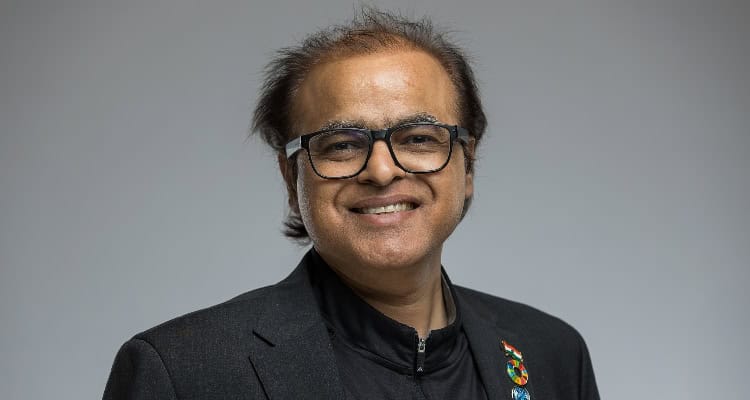Dr Rajendra Pratap Gupta, Chairman, Academy of Digital Health Sciences and UN’ IGF’s Dynamic Coalition on Digital Health, and advisor to the Union Health Minister, opines that those who embrace the next tool not only safeguard their patients—they future-proof their own practice
 Dr Rajendra Pratap Gupta, Chairman, Academy of Digital Health Sciences and UN’ IGF’s Dynamic Coalition on Digital Health, and advisor to the Union Health Minister
Dr Rajendra Pratap Gupta, Chairman, Academy of Digital Health Sciences and UN’ IGF’s Dynamic Coalition on Digital Health, and advisor to the Union Health Minister
“Digital health is not about apps or gadgets—it’s about transforming how health systems serve people.” — Dr Tedros Adhanom Ghebreyesus, Director-General, WHO
The stethoscope defined 19th-century medicine; computers and electronic health records shaped the past three decades. In 2025, the defining tool of the profession is no longer a single device but a structured discipline: Digital Health. From IoT-based point of care diagnostics to AR, VR, gaming, DTx, remote monitoring and more, the digital layer now touches every point of care. It has matured so fast—and proven so indispensable—that treating “digital” as an optional skill set is a risk no clinician, hospital, or health system can take.
-
Digital health ≠ Just AI
Artificial intelligence grabs headlines, but AI is only one blade in a much larger Swiss-army knife. Digital health also encompasses telemedicine platforms, mobile diagnostics, connected implants, electronic medical records, blockchain-secured supply chains, augmented-reality surgical guidance, and FDA-regulated digital therapeutics. Mastering the full toolkit is now as fundamental as anatomy.
-
Patients already expect hybrid care
Hybrid models—combining in-person and virtual visits—are becoming the new default. In the last 12 months alone, 82 per cent of patients and 83 per cent of clinicians said hybrid care is their preferred mode of interaction. These numbers are still climbing. So, if you cannot deliver seamless digital touch-points, someone else will.
-
Specialty tools that are no longer “Nice to Have”
If we look at various specialties, digital health is integrating fast.
- Radiology — Cloud-based PACS & AI triage dashboards: AI-generated draft reports cut average reporting time from 573 to 435 seconds (≈24 per cent faster) without sacrificing accuracy in a 2024 pilot study.
- Pathology — Whole-slide imaging plus AI decision support: A six-centre study presented at ASCO 2025 raised diagnostic agreement for HER2-low breast-cancer scoring to 86.4 per cent (up from 73.5 per cent), slashing misclassification by 65 per cent.
- Cardiology — Connected ECG patches & remote-patient-monitoring dashboards: The global RPM market is projected to soar from USD 18.23 bn (2023) to USD 88.92 bn by 2032, fuelled chiefly by cardiovascular use-cases.
- Endocrinology — Continuous-glucose-monitor APIs integrated with EHRs: A 25-trial meta-analysis showed CGM-based feedback trims HbA1c by an average of 0.28 percentage points versus self-monitoring.
- Neurology & Psychiatry — FDA-cleared prescription digital therapeutics (PDTs): In April 2025, the FDA authorised CT-132, the first app-based preventive therapy for episodic migraine, giving 37 million U.S. patients a non-drug option.
- International Patients’ Union is likely to launch a digital Primary Care Physician by the end of the year.
-
Why formal sub-specialisation matters
- Clinical quality & safety
Digital competence is now directly tied to outcomes—whether catching silent arrhythmias on a patch ECG or choosing the right AI-assisted pathology workflow.
- Regulatory & reimbursement shifts
As of May 2025, 129 countries have national digital-health strategies; the World Health Assembly has extended the global strategy to 2027 and ordered the next phase through 2033. Skills in interoperability, data governance, and ethical AI may soon be licensure requirements.
- Patient trust & market differentiation
“Digital-first” providers see higher patient-satisfaction scores and lower no-show rates. In competitive urban markets, a friction-free portal can be the difference between loyalty and leakage when care transitions from bedside to website.
- Career durability
Tools such as large-language models, scribes or auto-planning radiotherapy systems augment clinicians who understand them—but will sideline those who do not. Digital literacy has become the new lifelong-learning insurance policy.
-
Predictions that raise the stakes
- By 2030, more than 50 per cent of chronic-care visits will occur via a remote or hybrid model.
- By 2030, remote patient-monitoring revenues will be among the top revenue generators
- Before the end of this decade, every blockbuster drug will launch with an adjunctive software companion—making digital therapeutics literacy as essential as pharmacology.
-
From recommendation to requirement
Four years ago, learning tele-health was a résumé booster. Today, digital health is the backbone of modern medicine. Integrating it formally—as a sub-speciality akin to critical care or sports medicine—will:
- Provide structured competencies.
- Help in creating new clinical pathways.
- More outcome-based – value-based care.
- Completely redo the conventional healthcare delivery model.
Doctors once resisted the stethoscope, the X-ray, and even the HER, but all these tools are widely accepted now. History shows that those who embrace the next tool not only safeguard their patients—they future-proof their own practice.
“The clinic no longer ends at the door; it follows the patient home, to work, and onto every connected device.” Digital health is the next toolset. The only real question is whether we teach it to every clinician now or play catch-up when our patients have already moved on.
The prescription is clear: make digital health the must-have sub-specialisation of the 2020s—because medicine’s future has already logged in.